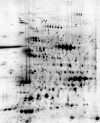Proteome profiling of Populus euphratica Oliv. upon heat stress - PubMed (original) (raw)
Proteome profiling of Populus euphratica Oliv. upon heat stress
Sílvia Ferreira et al. Ann Bot. 2006 Aug.
Abstract
Background and aims: Populus euphratica is a light-demanding species ecologically characterized as a pioneer. It grows in shelter belts along riversides, being part of the natural desert forest ecosystems in China and Middle Eastern countries. It is able to survive extreme temperatures, drought and salt stress, marking itself out as an important plant species to study the mechanisms responsible for survival of woody plants under heat stress.
Methods: Heat effects were evaluated through electrolyte leakage on leaf discs, and LT(50) was determined to occur above 50 degrees C. Protein accumulation profiles of leaves from young plants submitted to 42/37 degrees C for 3 d in a phytotron were determined through 2D-PAGE, and a total of 45 % of up- and downregulated proteins were detected. Matrix-assisted laser desorption ionization-time of flight (MALDI-TOF)/TOF analysis, combined with searches in different databases, enabled the identification of 82 % of the selected spots.
Key results: Short-term upregulated proteins are related to membrane destabilization and cytoskeleton restructuring, sulfur assimilation, thiamine and hydrophobic amino acid biosynthesis, and protein stability. Long-term upregulated proteins are involved in redox homeostasis and photosynthesis. Late downregulated proteins are involved mainly in carbon metabolism.
Conclusions: Moderate heat response involves proteins related to lipid biogenesis, cytoskeleton structure, sulfate assimilation, thiamine and hydrophobic amino acid biosynthesis, and nuclear transport. Photostasis is achieved through carbon metabolism adjustment, a decrease of photosystem II (PSII) abundance and an increase of PSI contribution to photosynthetic linear electron flow. Thioredoxin h may have a special role in this process in P. euphratica upon moderate heat exposure.
Figures
Fig. 1.
Percentage of membrane damage of leaf cells from plants of P. euphratica submitted to temperatures up to 55 °C. Columns represent the average percentage membrane damage, calculated from the results of three independent experiments. The _y_-axis represents the total percentage of electrolyte leakage and the _x_-axis represents the temperature, in °C, to which leaf discs were exposed.
Fig. 2
Position of identified spots from 2D 12·5 % polyacrylamide gels. From left to right, pI 4–7 linear range. Arrowheads indicate the spots identified by mass spectrometry, together with the respective spot number presented in Table 2.
Similar articles
- Physiological and proteomic responses of two contrasting Populus cathayana populations to drought stress.
Xiao X, Yang F, Zhang S, Korpelainen H, Li C. Xiao X, et al. Physiol Plant. 2009 Jun;136(2):150-68. doi: 10.1111/j.1399-3054.2009.01222.x. Epub 2009 Feb 12. Physiol Plant. 2009. PMID: 19453505 - Proteomic study of Carissa spinarum in response to combined heat and drought stress.
Zhang M, Li G, Huang W, Bi T, Chen G, Tang Z, Su W, Sun W. Zhang M, et al. Proteomics. 2010 Sep;10(17):3117-29. doi: 10.1002/pmic.200900637. Proteomics. 2010. PMID: 20661954 - Mapping the proteome of poplar and application to the discovery of drought-stress responsive proteins.
Plomion C, Lalanne C, Claverol S, Meddour H, Kohler A, Bogeat-Triboulot MB, Barre A, Le Provost G, Dumazet H, Jacob D, Bastien C, Dreyer E, de Daruvar A, Guehl JM, Schmitter JM, Martin F, Bonneu M. Plomion C, et al. Proteomics. 2006 Dec;6(24):6509-27. doi: 10.1002/pmic.200600362. Proteomics. 2006. PMID: 17163438 - Progress in studying heteromorphic leaves in Populus euphratica: leaf morphology, anatomical structure, development regulation and their ecological adaptation to arid environments.
Song Z, Ni X, Yao J, Wang F. Song Z, et al. Plant Signal Behav. 2021 Apr 3;16(4):1870842. doi: 10.1080/15592324.2020.1870842. Epub 2021 Jan 11. Plant Signal Behav. 2021. PMID: 33427562 Free PMC article. Review. - [Heat-responsive mechanisms in plants revealed by proteomic analysis: A review].
Liu JM, Zhao Q, Yin ZP, Xu CX, Wang QH, Dai SJ. Liu JM, et al. Ying Yong Sheng Tai Xue Bao. 2015 Aug;26(8):2561-70. Ying Yong Sheng Tai Xue Bao. 2015. PMID: 26685622 Review. Chinese.
Cited by
- Structural and Functional Heat Stress Responses of Chloroplasts of Arabidopsis thaliana.
Paul P, Mesihovic A, Chaturvedi P, Ghatak A, Weckwerth W, Böhmer M, Schleiff E. Paul P, et al. Genes (Basel). 2020 Jun 12;11(6):650. doi: 10.3390/genes11060650. Genes (Basel). 2020. PMID: 32545654 Free PMC article. - Effects of heavy metals and arbuscular mycorrhiza on the leaf proteome of a selected poplar clone: a time course analysis.
Lingua G, Bona E, Todeschini V, Cattaneo C, Marsano F, Berta G, Cavaletto M. Lingua G, et al. PLoS One. 2012;7(6):e38662. doi: 10.1371/journal.pone.0038662. Epub 2012 Jun 26. PLoS One. 2012. PMID: 22761694 Free PMC article. - Populus euphratica: an incompatible host for biotrophic pathogens?
Palma Ferreira S. Palma Ferreira S. Mol Plant Pathol. 2016 Sep;17(7):999-1003. doi: 10.1111/mpp.12437. Mol Plant Pathol. 2016. PMID: 27492503 Free PMC article. No abstract available. - Leaf cDNA-AFLP analysis of two citrus species differing in manganese tolerance in response to long-term manganese-toxicity.
Zhou CP, Qi YP, You X, Yang LT, Guo P, Ye X, Zhou XX, Ke FJ, Chen LS. Zhou CP, et al. BMC Genomics. 2013 Sep 14;14:621. doi: 10.1186/1471-2164-14-621. BMC Genomics. 2013. PMID: 24034812 Free PMC article.
References
- Andersen B, Scheller HV, Moller BL. 1992. The PSI-E subunit of photosystem I binds ferredoxin:NADP+ oxidoreductase. FEBS Letters 311: 169–73. - PubMed
- Avital S, Gromet-Elhanan Z. 1991. Extraction and purification of the beta subunit and an active alpha beta-core complex from the spinach chloroplast CFoF1-ATP synthase. Journal of Biological Chemistry 266: 7067–7072. - PubMed
- Belanger FC, Leustek T, Chu B, Kriz AL. 1995. Evidence for the thiamine biosynthetic pathway in higher-plant plastids and its developmental regulation. Plant Molecular Biology 29: 809–21. - PubMed
- Besse I, Buchanan BB. 1997. Thioredoxin-linked plant and animal processes: the new generation. Botanical Bulletin of Academia Sinica 38: 1–11.

